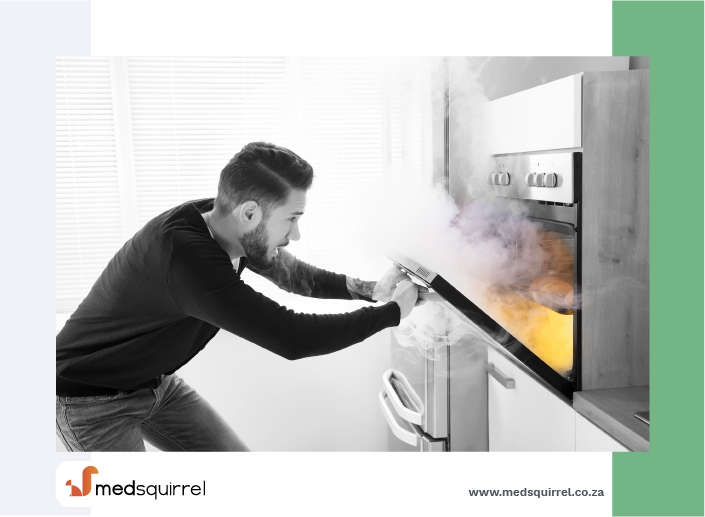Back First Aid Explained
Burns: First Aid

We have selected the following expert medical opinion based on its clarity, reliability and accuracy. Credits: Sourced from the Mayo Clinic, Minnesota. Please refer to your own medical practitioner for a final perspective, assessment or evaluation.
Is it a minor burn or a major burn?
If it's not clear what level of care is needed, try to judge the extent of tissue damage, based on the following burn categories:
1st-degree burn
A first-degree burn is the least serious type, involving only the outer layer of skin. It may cause:
- Redness
- Swelling
- Pain
You can usually treat a first-degree burn as a minor burn. If it involves much of the hands, feet, face, groin, buttocks or a major joint, seek emergency medical attention.
2nd-degree burn
A second-degree burn is more serious. It may cause:
- Red, white or splotchy skin
- Swelling
- Pain
- Blisters
If the second-degree burn is no larger than 3 inches (7.6 centimeters) in diameter, treat it as a minor burn. If the burned area is larger or covers the hands, feet, face, groin, buttocks or a major joint, treat it as a major burn and get medical help immediately.
3rd-degree burns
The most serious burns involve all layers of the skin and underlying fat. Muscle and even bone may be affected. Burned areas may be charred black or white.
The person may experience:
- Difficulty breathing
- Carbon monoxide poisoning
- Other toxic effects, if smoke inhalation also occurred
Minor burns
For minor burns:
Cool the burn to help soothe the pain
Hold the burned area under cool (not cold) running water for 10 to 15 minutes or until the pain eases. Or apply a clean towel dampened with cool tap water.
Remove rings or other tight items from the burned area
Try to do this quickly and gently, before the area swells.
Don't break small blisters (no bigger than your little fingernail)
If blisters break, gently clean the area with mild soap and water, apply an antibiotic ointment, and cover it with a nonstick gauze bandage.
Apply moisturizer or aloe vera lotion or gel
Moisturizer or aloe vera lotion or gel may provide relief in some cases.
If needed, take an over-the-counter pain reliever
Such as ibuprofen (Advil, Motrin IB, others), naproxen sodium (Aleve) or acetaminophen (Tylenol, others).
Consider a tetanus shot
Make sure that your tetanus booster is up to date. Doctors recommend people get a tetanus shot at least every 10 years.
See your doctor if you develop large blisters
Large blisters are best removed, as they rarely will remain intact on their own. Also seek medical help if the burn covers a large area of the body or if you notice signs of infection, such as oozing from the wound and increased pain, redness and swelling.
Major burns
Call emergency medical help for major burns.
(See "EMERGENCY NUMBERS" above)
Until an emergency unit arrives, take these actions:
Protect the burned person from further harm
If you can do so safely, make sure the person you're helping is not in contact with smoldering materials or exposed to smoke or heat. But don't remove burned clothing stuck to the skin.
Check for signs of circulation
Look for breathing, coughing or movement. Begin CPR if needed.
Remove jewelry, belts and other restrictive items
Remove these items especially from around burned areas and the neck. Burned areas swell rapidly.
Don't immerse large severe burns in cold water
Doing so could cause a serious loss of body heat (hypothermia) or a drop in blood pressure and decreased blood flow (shock).
Elevate the burned area
Raise the wound above heart level, if possible.
Cover the area of the burn
Use a cool, moist, bandage or a clean cloth.
_______________________________________________________________________________________________________________________
Are you a healthcare practitioner who enjoys patient education, interaction and communication?
If so, we invite you to criticise, contribute to or help improve our content. We find that many practicing doctors who regularly communicate with patients develop novel and often highly effective ways to convey complex medical information in a simplified, accurate and compassionate manner.
MedSquirrel is a shared knowledge, collective intelligence digital platform developed to share medical expertise between doctors and patients. We support collaboration, as opposed to competition, between all members of the healthcare profession and are striving towards the provision of peer reviewed, accurate and simplified medical information to patients. Please share your unique communication style, experience and insights with a wider audience of patients, as well as your colleagues, by contributing to our digital platform.
Your contribution will be credited to you and your name, practice and field of interest will be made visible to the world. (Contact us via the orange feed-back button on the right).
Disclaimer:
MedSquirrel is a shared knowledge, collective intelligence digital platform developed to share medical knowledge between doctors and patients. If you are a healthcare practitioner, we invite you to criticise, contribute or help improve our content. We support collaboration among all members of the healthcare profession since we strive for the provision of world-class, peer-reviewed, accurate and transparent medical information.
MedSquirrel should not be used for diagnosis, treatment or prescription. Always refer any questions about diagnosis, treatment or prescription to your Doctor.
